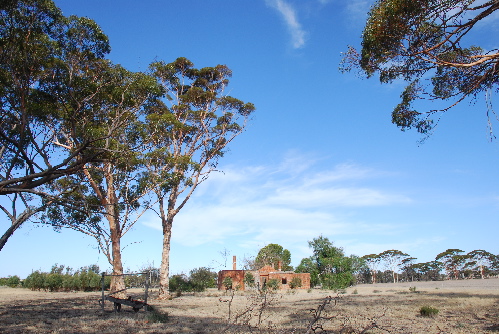The other day I was 160 kms east of Perth, in the area of land known as ‘the wheat belt’ for its growing of large amounts of wheat. I was visiting a farmer by the name of Kim, a friend of a friend, and a guy who has spent his whole life calling this four and a half thousand acres of semi-arid sheep and wheat growing country home. Welcome to the farming life: long hours of looking after sheep and hanging out with sheep dogs, dark, quiet nights, lots of space and the odd eagle soaring overhead. I couldn’t do it – even though I love the space and the quiet – and I’ll be thanking the farmers next time I eat a bit of bread in the city.
This is where Kim and his sister and mother and father started out, later moving into a more modern house. For a deracinated urbanite like myself it is difficult to imagine having such a continuity of attachment to home. Surely behind the laconic and bluff patter of the Australian farmer lies a deep sense of belonging?
The trees have mostly been chopped down decades ago in this part of the world, and the roots of the trees which used to keep the water table lower are now mostly gone. The water has risen as a result, bringing salt from down in the earth to the surface and killing all the plants in its way. Kim showed me dead trees which had been alive and well when he was a kid in the fifties.
These are salt bushes which Kim has planted. By doing so he is laying down plants that will soak up the salty water in the ground, thereby combating the march of the salt. He has planted thousands and thousands of trees and salt bushes each year and he is winning the fight. On the other hand, many farmers do not have such foresight. And even if they did, it seems to me that what is needed is not just such action on certain strips of farming country, but for the government to buy back twenty per cent of the wheat belt and set it aside to conserve the thousands of species of plants which grow out here. If the Greens were in government you could expect that kind of result.
If any of you reading this blog in Perth would like to come out to Kim’s property in July of 2007 and plant some trees for a day or two, then let me know. Kim loves nature and its diversity of species, and has offered to put us up at his place so that we can do some planting. Rather than paying for carbon offsets, why not just come out and stick some seedlings in the ground youself?
These days Austalians aren’t the most agrarian folk you’ll find. We have gone, in a handful of generations, from bush pioneers to city slickers. As of 2000, 91 per cent of Australians live in urban areas. In the context of the democratic West, Australia is the second most urbanized country after Belgium. Although I’ve no deep affinity with the rough culture of Australian farmers, I do feel invigorated by the colours of the salmon gum in half-light and the huge amounts of tourist-free space everywhere you go, up hill and down. And I’m glad I’ve made a connection with a person who produces my food and sees beyond the city pavements.

